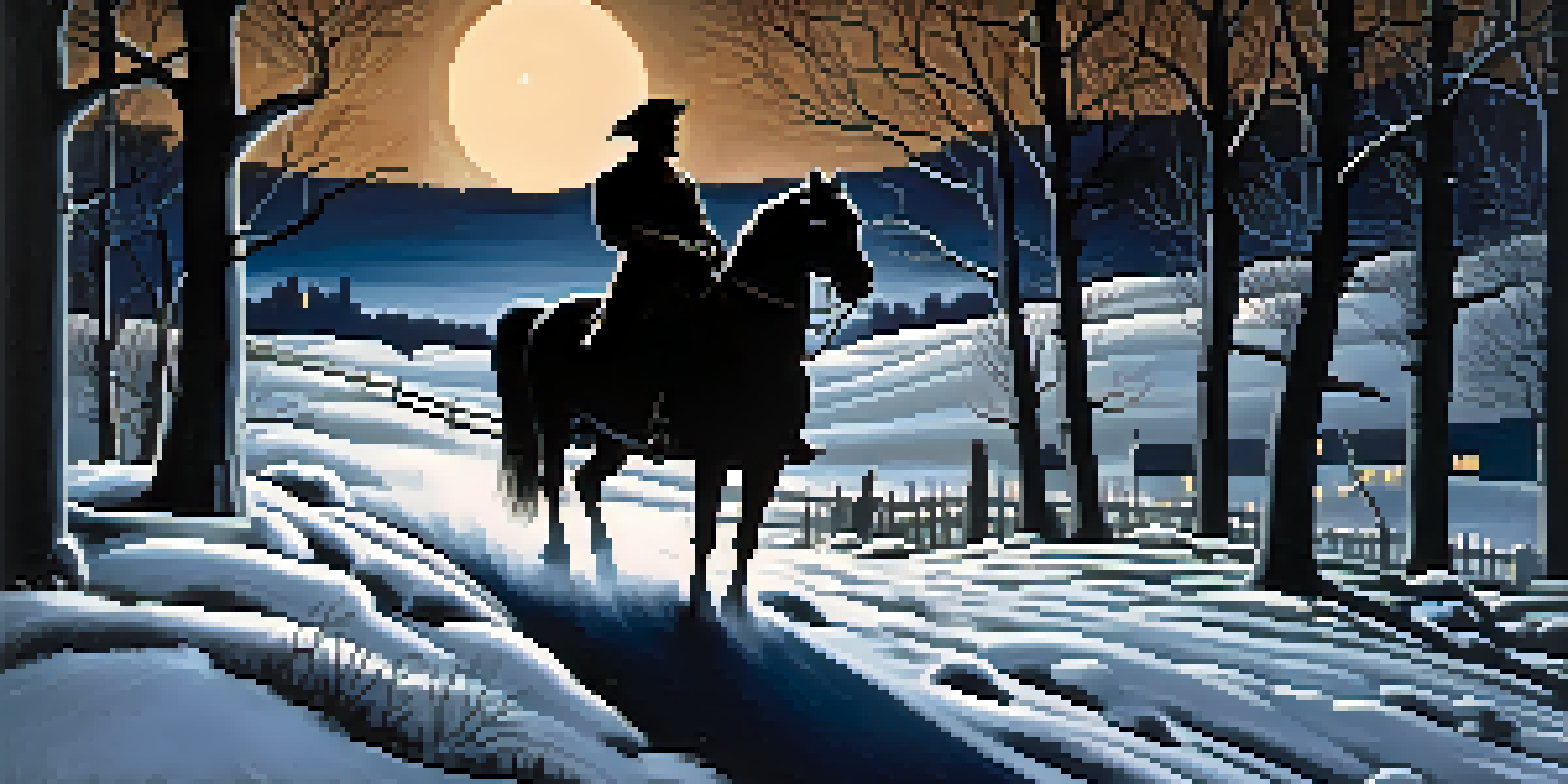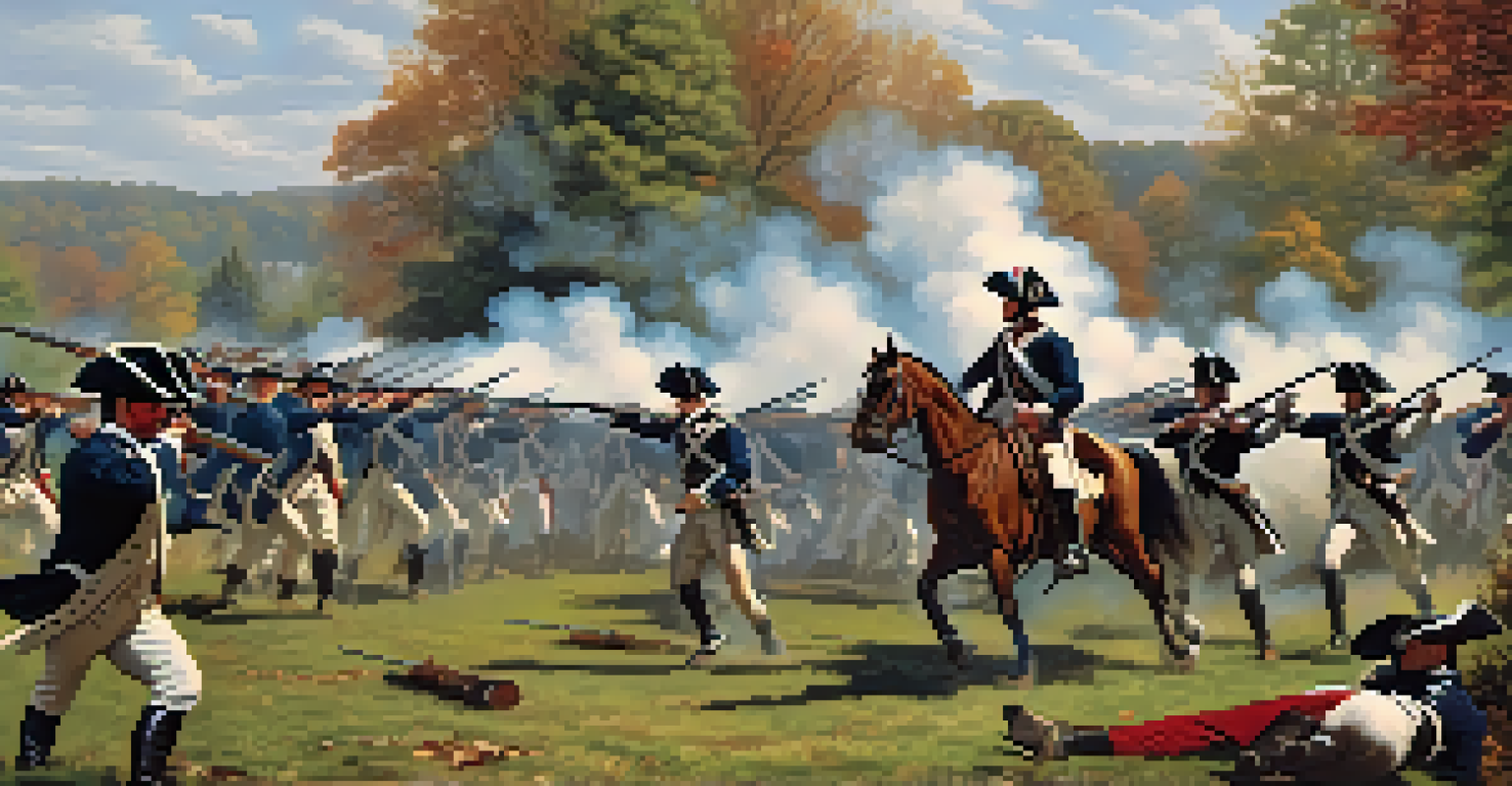Paul Revere's Midnight Ride: The Call to Arms

Setting the Stage: Tensions in Colonial America
In the years leading up to 1775, tensions between American colonists and British authorities were at an all-time high. The imposition of taxes without representation and oppressive laws fueled a growing desire for independence among the colonists. This atmosphere of unrest laid the groundwork for significant events that would soon unfold, especially in New England.
The shot heard 'round the world.
By the time of Paul Revere's midnight ride, many colonists were already organizing and preparing for potential conflict. The Sons of Liberty, a group dedicated to resisting British control, were particularly active in spreading awareness and rallying support. This environment of urgency among patriots created a fertile ground for Revere's mission.
The feeling of impending conflict was palpable, and communication among the colonies was crucial. As whispers of British troop movements reached the ears of Revere and his compatriots, the necessity for swift action became clear. Little did they know, their actions would soon become legendary.
Paul Revere: The Man Behind the Legend
Paul Revere was not just a silversmith; he was a man deeply involved in the revolutionary cause. His skills as an engraver and his connections within the community made him a vital part of the colonial resistance. But it was his bravery and quick thinking that would lead him to become a pivotal figure in American history.

On the night of April 18, 1775, Revere was entrusted with the critical task of alerting his fellow patriots to the British troops' advance. This was no small feat; he had to navigate through the countryside, avoiding capture while ensuring the message reached key leaders. His determination and sense of urgency exemplified the spirit of those fighting for independence.
Colonial Tensions Sparked Independence
Growing unrest due to British taxes and laws fueled a desire for independence among American colonists.
Revere's background and reputation lent credibility to his mission. People trusted him, and that trust was essential for the success of his ride. His character and dedication to the cause of liberty would soon become woven into the fabric of American folklore.
The Famous Ride: A Night of Urgency
As the clock struck midnight, Revere set out on his horse, ready to deliver the crucial message that the British were coming. He rode through the dark, rural landscape of Massachusetts, calling out to every patriot he encountered. His journey was fraught with danger, as British patrols were actively searching for rebels.
What a piece of work is man! How noble in reason, how infinite in faculty!
Revere's ride was marked by a series of stops, each one significant in rallying the local militias. He reached Lexington first, where he warned Samuel Adams and John Hancock, two prominent leaders of the revolution. His quick thinking and relentless pursuit of spreading the alarm were critical in mobilizing the local forces.
As he continued towards Concord, Revere's calls echoed the urgency of the moment. Every mile he covered brought him closer to not just the next village but also the impending clash with British forces. His ride was more than just a journey; it was a pivotal moment that ignited the flame of rebellion across the colonies.
The Role of Other Riders: A Collaborative Effort
While Paul Revere is often celebrated as the lone rider, he was part of a broader network of patriots working together to warn their fellow colonists. Fellow riders, such as William Dawes and Dr. Samuel Prescott, also played crucial roles in spreading the alarm. Their collective efforts ensured that the message reached multiple towns quickly.
These riders faced similar dangers as they navigated the dark and treacherous roads. Each one understood the gravity of their task, knowing that the future of the colonies depended on their success. The collaboration among these patriots is a testament to the unity that characterized the revolutionary spirit.
Revere's Ride Ignited Revolutionary Spirit
Paul Revere's midnight ride was crucial in mobilizing colonists and warning them of British troop movements.
Their combined efforts not only spread the word but also helped organize the local militia. As news of the British advance reached more and more ears, the colonists began to prepare for what would soon become the Battles of Lexington and Concord. It was a prime example of how teamwork can amplify an important cause.
The Aftermath: Battles of Lexington and Concord
The warnings delivered by Revere and his fellow riders set the stage for the first military engagements of the American Revolutionary War. On April 19, 1775, British troops reached Lexington, where they encountered armed colonists. The confrontation marked a turning point, signaling that the colonists were ready to stand up against British authority.
The Battles of Lexington and Concord were not just skirmishes; they represented the culmination of years of tension and unrest. The phrase 'the shot heard 'round the world' is often used to describe the opening shot of the conflict, highlighting its significance. The colonists' resolve became clear, and the fight for independence had officially begun.
As news of the battles spread, more colonists were inspired to join the fight. The initial resistance at Lexington and Concord galvanized support for the revolutionary cause, proving that the calls to arms had been effective. It was the beginning of a long struggle for freedom, driven by the actions of individuals like Paul Revere.
Legacy of Paul Revere's Ride in American Culture
Paul Revere's midnight ride has transcended its historical context to become an enduring symbol of American patriotism and bravery. Long after the events of 1775, Revere's story has been immortalized in poems, songs, and folklore. Henry Wadsworth Longfellow's famous poem, 'Paul Revere's Ride,' played a significant role in cementing his legacy in the national consciousness.
The narrative of a lone hero galloping through the night has inspired countless generations. Revere's ride embodies the spirit of taking action in the face of adversity and the importance of community in times of crisis. His story serves as a reminder that individual courage can spark collective action.
Legacy of Courage and Community
Revere's actions symbolize the collective spirit of resistance that inspired the fight for American independence.
Today, Paul Revere is celebrated as a national hero, with monuments and historical sites dedicated to his memory. His legacy is a testament to the power of one person's determination to ignite change, reminding us that every action counts in the pursuit of freedom.
Conclusion: The Significance of Revere's Ride
Paul Revere's midnight ride was much more than just a warning; it was a catalyst for change in American history. His actions, alongside those of other patriots, set in motion a series of events that would ultimately lead to the founding of a new nation. The ride symbolizes the spirit of resistance and the importance of standing up for one's beliefs.
In reflecting on this pivotal moment, we recognize the courage and determination displayed by individuals like Revere. Their willingness to risk everything for the cause of liberty serves as an inspiration to us all. It reminds us of the ongoing struggle for freedom and the need for vigilance in protecting our rights.

As we look back at Revere's ride, we celebrate not just the man, but the collective spirit of a nation that chose to fight for its independence. His legacy continues to resonate today, reminding us that the fight for justice and freedom is a journey that never truly ends.